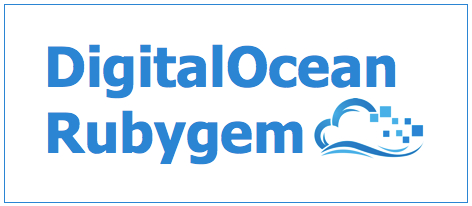https://github.com/motdotla/digitalocean
The easiest and most complete rubygem for DigitalOcean.
https://github.com/motdotla/digitalocean
Last synced: 7 months ago
JSON representation
The easiest and most complete rubygem for DigitalOcean.
- Host: GitHub
- URL: https://github.com/motdotla/digitalocean
- Owner: motdotla
- License: mit
- Created: 2013-03-08T21:01:31.000Z (over 12 years ago)
- Default Branch: master
- Last Pushed: 2022-02-14T11:15:06.000Z (almost 4 years ago)
- Last Synced: 2025-05-07T04:09:09.515Z (7 months ago)
- Language: Ruby
- Homepage: http://rubygems.org/gems/digitalocean
- Size: 208 KB
- Stars: 154
- Watchers: 18
- Forks: 37
- Open Issues: 0
-
Metadata Files:
- Readme: README.md
- License: LICENSE.txt
Awesome Lists containing this project
- awesome - digitalocean
README
[](http://www.opensourcecitizen.org/project?url=github.com/motdotla/digitalocean)
If you found this library useful, donate some CPU cycles to this project by clicking above. Thank you! 😇
# Digitalocean Rubygem

### The easiest and most complete rubygem for [DigitalOcean](https://www.digitalocean.com).
NOTICE: This is a DigitalOcean V1 API client. It supports everything, the V1 API can do with a simple interface written in Ruby. Use [DropletKit](https://github.com/digitalocean/droplet_kit) for consuming the DigitalOcean V2 API.
[](https://travis-ci.org/motdotla/digitalocean)
[](http://badge.fury.io/rb/digitalocean)
```ruby
Digitalocean.client_id = "your_client_id"
Digitalocean.api_key = "your_api_key"
result = Digitalocean::Droplet.all
# =>
# 12345, "name"=>"dev", "image_id"=>2676, "size_id"=>63, "region_id"=>3, "backups_active"=>false, "ip_address"=>"198.555.55.55", "private_ip_address"=>nil, "locked"=>false, "status"=>"active", "created_at"=>"2013-06-12T03:07:14Z"},
# {"id"=>234674, "name"=>"server2", "image_id"=>441012, "size_id"=>62, "region_id"=>1, "backups_active"=>false, "ip_address"=>"192.555.55.56", "private_ip_address"=>nil, "locked"=>false, "status"=>"active", "created_at"=>"2013-06-17T00:30:12Z"}
# ]>
#
result.status
result.droplets
result.droplets.first.ip_address
```
## Installation
Add this line to your application's Gemfile:
```
gem 'digitalocean'
```
And then execute:
```
bundle
```
Or install it yourself as:
```
gem install digitalocean
```
Then in your application initialize the gem:
```ruby
Digitalocean.client_id = "your_client_id"
Digitalocean.api_key = "your_api_key"
```
You can find your keys at [https://cloud.digitalocean.com/api_access](https://cloud.digitalocean.com/api_access)
[](https://cloud.digitalocean.com/api_access)
## Usage
### List Droplets
```ruby
Digitalocean::Droplet.all
```
### Find Droplet
```ruby
Digitalocean::Droplet.find("id_of_droplet")
```
### Create Droplet
```ruby
Digitalocean::Droplet.create({:name => droplet_name, :size_id => size_id, :image_id => image_id, :region_id => region_id})
```
## Available Commands
```ruby
Digitalocean::Domain.all
Digitalocean::Domain.find(id)
Digitalocean::Domain.create({name: name, ip_address: ip_address})
Digitalocean::Domain.destroy(id)
Digitalocean::Droplet.all
Digitalocean::Droplet.find(id)
Digitalocean::Droplet.rename(id, {name: name})
Digitalocean::Droplet.reboot(id)
Digitalocean::Droplet.power_cycle(id)
Digitalocean::Droplet.shutdown(id)
Digitalocean::Droplet.power_off(id)
Digitalocean::Droplet.power_on(id)
Digitalocean::Droplet.snapshot(id, {name: name})
Digitalocean::Droplet.create({name: name, size_id: size_id, image_id: image_id, region_id: region_id, ssh_key_ids: ssh_key_ids})
Digitalocean::Droplet.destroy(id)
Digitalocean::Droplet.resize(id, {size_id: size_id})
Digitalocean::Image.all
Digitalocean::Image.all({filter: "my_images"})
Digitalocean::Image.find(id)
Digitalocean::Image.destroy(id)
Digitalocean::Image.transfer(id, {region_id: region_id})
Digitalocean::Record.all(domain_id)
Digitalocean::Record.find(domain_id, record_id)
Digitalocean::Record.create(domain_id, {record_type: record_type, data: data})
Digitalocean::Record.edit(domain_id, record_id, {record_type: record_type, data: data})
Digitalocean::Record.destroy(domain_id, record_id)
Digitalocean::Region.all
Digitalocean::Region.find(region_id)
Digitalocean::Size.all
Digitalocean::Size.find(size_id)
Digitalocean::SshKey.all
Digitalocean::SshKey.find(id)
Digitalocean::SshKey.create({name: name, ssh_pub_key: ssh_pub_key}) # Keep in mind you have to use CGI::escape for your ssh_pub_key
Digitalocean::Event.find(id)
```
## Example
There is a [digitalocean-rubygem-example](https://github.com/scottmotte/digitalocean-rubygem-example) to help jumpstart your development.[tada]
## Options
```ruby
Digitalocean.verify_ssl = false # optionally set this to false. defaults to true.
```
## Contributing
1. Fork it
2. Create your feature branch (`git checkout -b my-new-feature`)
5. Commit your changes (`git commit -am 'Add some feature'`)
6. Push to the branch (`git push origin my-new-feature`)
7. Create new Pull Request
When adding methods, add to the list of DEFINITIONS in `lib/digitalocean.rb`. Additionally, write a spec and add it to the list in the README.
## Running Specs
```
bundle exec rspec spec/*
```
## Publish to RubyGems.org
You first need to request access from [scottmotte](http://github.com/scottmotte).
```
gem build digitalocean.gemspec
gem push digitalocean-1.0.1.gem
```